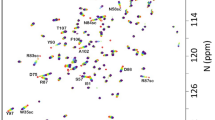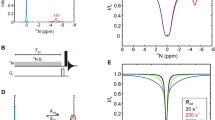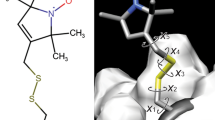Abstract
Sensitivity of the electron paramagnetic resonance (CW EPR) to molecular tumbling provides potential means for studying processes of molecular association. It uses spin-labeled macromolecules, whose CW EPR spectra may change upon binding to other macromolecules. When a spin-labeled molecule is mixed with its liganding partner, the EPR spectrum constitutes a linear combination of spectra of the bound and unbound ligand (as seen in our example of spin-labeled cytochrome c 2 interacting with cytochrome bc 1 complex). In principle, the fraction of each state can be extracted by the numerical decomposition of the spectrum; however, the accuracy of such decomposition may often be compromised by the lack of the spectrum of the fully bound ligand, imposed by the equilibrium nature of molecular association. To understand how this may affect the final estimation of the binding parameters, such as stoichiometry and affinity of the binding, a series of virtual titration experiments was conducted. Our non-linear regression analysis considered a case in which only a single class of binding sites exists, and a case in which classes of both specific and non-specific binding sites co-exist. The results indicate that in both models, the error due to the unknown admixture of the unbound ligand component in the EPR spectrum causes an overestimation of the bound fraction leading to the bias in the dissociation constant. At the same time, the stoichiometry of the binding remains relatively unaffected, which overall makes the decomposition of the EPR spectrum an attractive method for studying protein–protein interactions in equilibrium. Our theoretical treatment appears to be valid for any spectroscopic techniques dealing with overlapping spectra of free and bound component.







Similar content being viewed by others
References
Bartsh RG (1971) Cytochromes: bacterial. Methods Enzymol 23:344–363
Biswas R, Kuhne H, Brudvig GW, Gopalan V (2001) Use of EPR spectroscopy to study macromolecular structure and function. Sci Prog 84:45–67
Brotherus JR, Jost PC, Griffith H, Keana JF, Hokin LE (1980) Charge selectivity at the lipid–protein interface of membranous Na,K-ATPase. Proc Natl Acad Sci USA 77:272–276
Budil ED, Lee S, Saxena S, Freed JH (1996) Nonlinear-least-squares analysis of slow-motion epr spectra in one and two dimensions using a modified Levenberg-Marquardt algorithm. J Magn Reson A 120:155–189
Columbus L, Hubbell WL (2002) A new spin on protein dynamics. Trends Biochem Sci 27:288–295
Doyle ML (1997) Characterization of binding interactions by isothermal titration calorimetry. Curr Opin Biotechnol 8:31–35
Ellis RJ (2001a) Macromolecular crowding: an important but neglected aspect of the intracellular environment. Curr Opin Struct Biol 11:114–119
Ellis RJ (2001b) Macromolecular crowding: obvious but underappreciated. Trends Biochem Sci 26:597–604
Erman JE, Vitello LB (1980) The binding of cytochrome c peroxidase and ferricytochrome c. A spectrophotometric determination of the equilibrium association constant as a function of ionic strength. J Biol Chem 10:6224–6227
Fajer PG (2000) EPR of proteins and peptides. In: Meyers RA (ed) Encyclopedia of analytical chemistry, Wiley, Chichester, pp 5725–5761
Farahbakhsh ZT, Huang QL, Ding LL, Altenbach C, Steinhoff HJ, Horwitz J, Hubbell WL (1995) Interaction of alpha-crystalin with spin-labeled peptides. Biochemistry 34:509–516
Feix J, Klug C (1998) Site-directed spin labeling of membrane proteins and peptide–membrane interaction. In: Berliner LJ (ed) Biological magnetic resonance, vol 14. Plenum, New York, pp 251–281
Green NM (1965) A spectrophotometric assay for avidin and biotin based on binding of dyes by avidin. Biochem J 94:23C–24C
Hamilton Syringe Calibration Report (2004)
Hubbell WL, Gross A, Langen R, Lietzow MA (1998) Recent advances in site-directed spin labeling of proteins. Curr Opin Struct Biol 8:649–656
Ilnicki J, Kozioł J, Oles T, Kostrzewa A, Galiński W, Gurbiel RJ, Froncisz W (1995) Saturation recovery EPR spectrometer. Mol Phys Rep 5:203–207
Klug CS, Su W, Liu J, Klebba PE, Feix JB (1995) Denaturant unfolding of the ferric enterobactin receptor and ligand-induced stabilization studied by site-directed spin labeling. Biochemistry 34:14230–14236
Leavitt S, Freire E (2001) Direct measurement of protein binding energetics by isothermal titration calorimetry. Curr Opin Struct Biol 11:560–566
Lewis LM, Thomas D (1992) Resolved conformational states of spin-labeled Ca-ATPase during the enzymatic cycle. Biochemistry 31:7381–7389
Marsh D (1989) Experimental methods in spin-label spectral analysis. In: Berliner LJ, Reuben J (eds) Biological magnetic resonance, vol 8. Plenum, New York, pp 255–303
Marsh D, Horváth LI (1998) Structure, dynamics and composition of the lipid–protein interface. Perspectives from spin-labeling. Biochim Biophys Acta 1376:267–296
Marsh D, Horváth LI, Swamy MJ, Mantripragada S, Kleinschmidt JH (2002) Interaction of membrane-spanning proteins with peripheral and lipid-anchored membrane proteins: perspectives from protein–lipid interactions (Review). Mol Membr Biol 19:247–255
Mendel CM, Mendel DB (1985) ‘Non-specific’ binding. The problem, and a solution. Biochem J 228:269–272
Munson PJ, Rodbard D (1983) Number of receptor sites from Scatchard and Klotz graphs: a constructive critique. Science 220:979–981
Norby JG, Ottolenghi P, Jensen J (1980) Scatchard plot: common misinterpretation of binding experiments. Anal Biochem 102:318–320
Park HY, Chun SB, Han S, Lee K, Kim K (1997) Interaction of cytochrome c and cytochrome c oxidase studied by spin-label EPR and site-directed mutagenesis. J Biochem Mol Biol 30:397–402
Piasecki W, Froncisz W, Hubbell WL (1998) A rectangular loop-gap resonator for EPR studies of aqueous samples. J Magn Reson 134:36–43
Pierce MM, Raman CS, Nall BT (1999) Isothermal titration calorimetry of protein–protein interactions. Methods 19:213–221
Pyka J, Osyczka A, Turyna B, Blicharski W, Froncisz W (2001) EPR studies of iso-1-cytochrome c: effect of temperature on two-component spectra of spin label attached to cysteine at position 102 and 47. Eur Biophys J 30:367–373
Robertson DE, Ding H, Chelminski PR, Slaughter C, Hsu J, Moomaw C, Tokito M, Daldal F, Dutton PL (1993) Hydroubiquinone-cytochrome c2 oxidoreductase from Rhodobacter capsulatus: definition of a minimal, functional isolated preparation. Biochemistry 32:1310–1317
Salamon Z, Tollin G (2001) Plasmon resonance spectroscopy: probing molecular interactions at surfaces and interfaces. Spectrosc Int J 15:161–175
Salamon Z, Brown MI, Tollin G (1999) Plasmon resonance spectroscopy: probing molecular interactions within membranes. Trends Biochem Sci 24:213–219
Scatchard G (1949) The attractions of proteins for small molecules and ions. Ann NY Acad Sci 51:660–672
Stein RA, Wilkinson JC, Guyer CA, Staros JV (2001) An analytical approach to the measurement of equilibrium binding constants: application to EGF binding to EGF receptors in intact cells measured by flow cytometry. Biochemistry 40:6142–6154
Swillens S (1995) Interpretation of binding curves obtained with high receptor concentrations: practical aid for computer analysis. Mol Pharmacol 47:1197–1203
Wang ZX (1995) An exact mathematical expression for describing competitive binding of two different ligands to a protein molecule. FEBS Lett 360:111–114
Wang ZX, Jiang RF (1996) A novel two-site binding equation presented in terms of the total ligand concentration. FEBS Lett 392:245–249
Wang ZX, Kumar NR, Srivastava DK (1992) A novel spectroscopic titration method for determining the dissociation constant and stoichiometry of protein–ligand complex. Anal Biochem 206:376–381
Yan Y, Marriott G (2003) Analysis of protein interactions using fluorescence technologies. Curr Opin Chem Biol 7:635–640
Zierler K (1989) Misuse of nonlinear Scatchard plots. Trends Biochem Sci 14:314–317
van Zoelen EJJ (1989) Receptor–ligand interaction: a new method for determining binding parameters without a priori assumption on non-specific binding. Biochem J 262:549–556
Acknowledgment
This work was supported by the State Committee for Scientific Research (KBN, Poland) grant KBN 3P04A 043 23.
Author information
Authors and Affiliations
Corresponding author
Rights and permissions
About this article
Cite this article
Sarewicz, M., Szytuła, S., Dutka, M. et al. Estimation of binding parameters for the protein–protein interaction using a site-directed spin labeling and EPR spectroscopy. Eur Biophys J 37, 483–493 (2008). https://doi.org/10.1007/s00249-007-0240-5
Received:
Revised:
Accepted:
Published:
Issue Date:
DOI: https://doi.org/10.1007/s00249-007-0240-5




